Clement Meadmore: The art of mid-century design
Jane Eckett
Distinctions between art and design are notoriously difficult to make; the imperative of functionality is far from unique to design while a concern with communicative strategies and the formal elements of design (line, colour, volume and so on) are often common to both. The popularity of those umbrella terms ‘creatives’ and ‘the creative industries’ in present day usage reflects the fact that many artists are regularly engaged in design work and many designers exhibit their work in fine art contexts, blurring nominal divides. Arguably this has always been the case (just think of Leonardo deftly switching back and forth between blueprints and panel paintings), yet historically we have tended to pigeonhole our creatives into one or other category.
Clement Meadmore has long been anointed an artist, despite working for over a decade as a high profile industrial designer. In part this is surely because his reputation as a sculptor eclipsed his earlier reputation as a designer; by the early 1960s he was widely regarded one of Australia’s top two or three sculptors (along with Robert Klippel and Norma Redpath) and after moving permanently to New York, in 1963, he regularly attracted commissions for prominent public sculptures. Yet this classification as an artist rather than artist-designer must also be considered a product of Meadmore’s own making. In two mid-career interviews he gave Hazel de Burgh (in 1962 and 1970) he foreclosed discussion of his early design career. Similarly, Eric Gibson’s monograph on Meadmore of 1994 dismissed his industrial design work in a line or two without any mention of individual works.
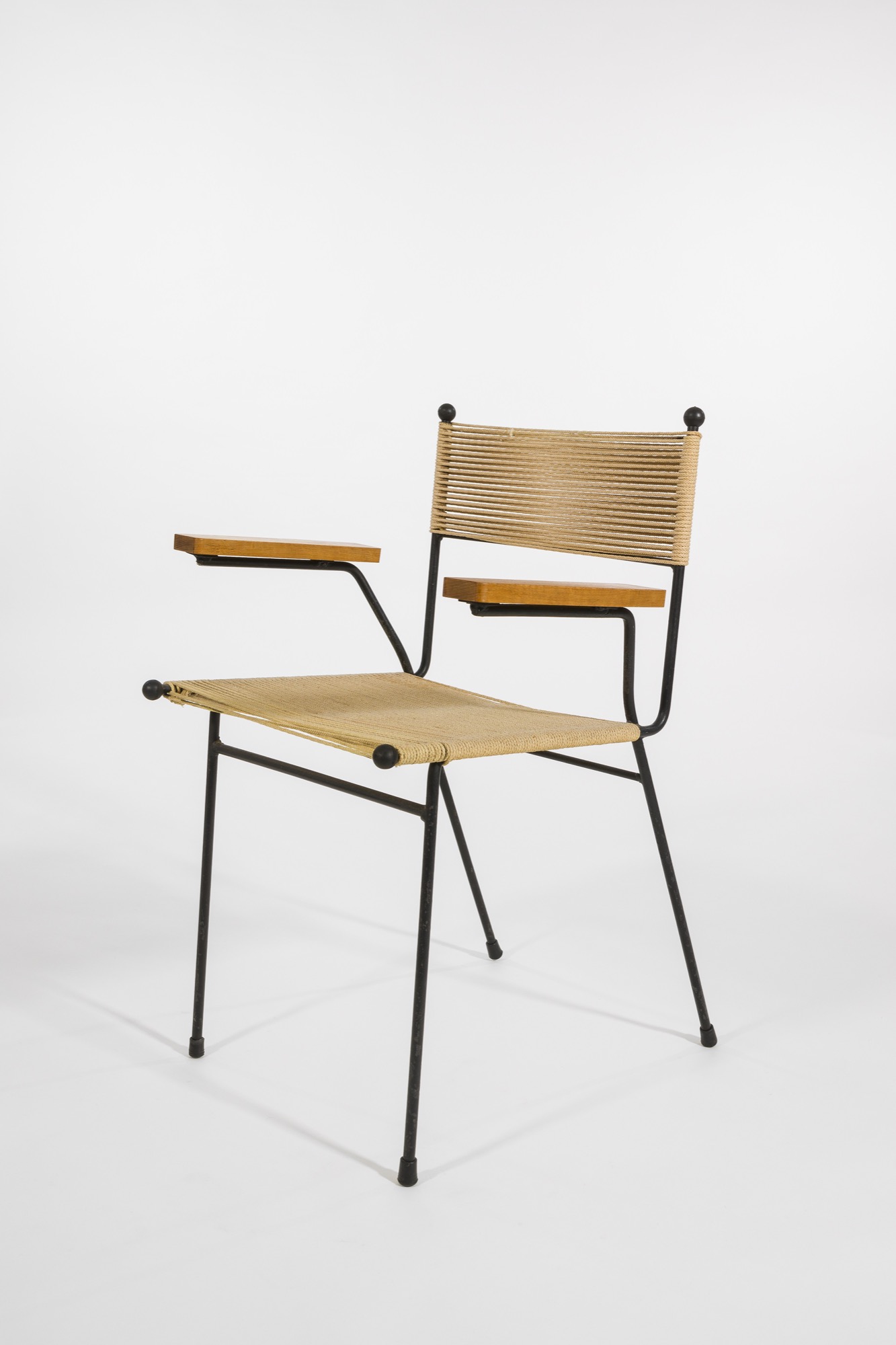
Nevertheless, Meadmore has long been credited as one of a handful of designers who significantly raised standards in furniture design in post-war Australia. His trademark black steel frame furniture, upholstered in blind cord or canvas or combined with glass or plywood, featured prominently in art and architectural publications of the fifties and won him several accolades, including at least two Good Design Awards from the Society of Interior Designers of Australia. In recent decades no curated exhibition of mid-century modern Australian furniture would be considered complete without an example of one of his chairs, coffee tables or reading lamps; indeed, his work featured prominently in the NGV’s Mid-Century Modern exhibition in 2014. More recently still, Meadmore’s design work has attracted increasing scholarly interest, ranging from case studies examining his interior design schemes for Ion Nicolades’ Legend Espresso and Milk Bar and the Teahouse (see for instance Nanette Carter, ‘Nipped in the Bud: Clement Meadmore’s interior for the Teahouse’, PDF Design History Australia Research Network, 2017), to detailed historical studies of the design practice Meadmore Originals (Simon Reeves, ‘Meadmore Originals’, RMIT Design Archives Journal, vol. 5, no. 2, 2015, pp. 4-25). Yet despite this evident widespread interest, until now we have lacked any comprehensive exhibition surveying Meadmore’s industrial design practice.
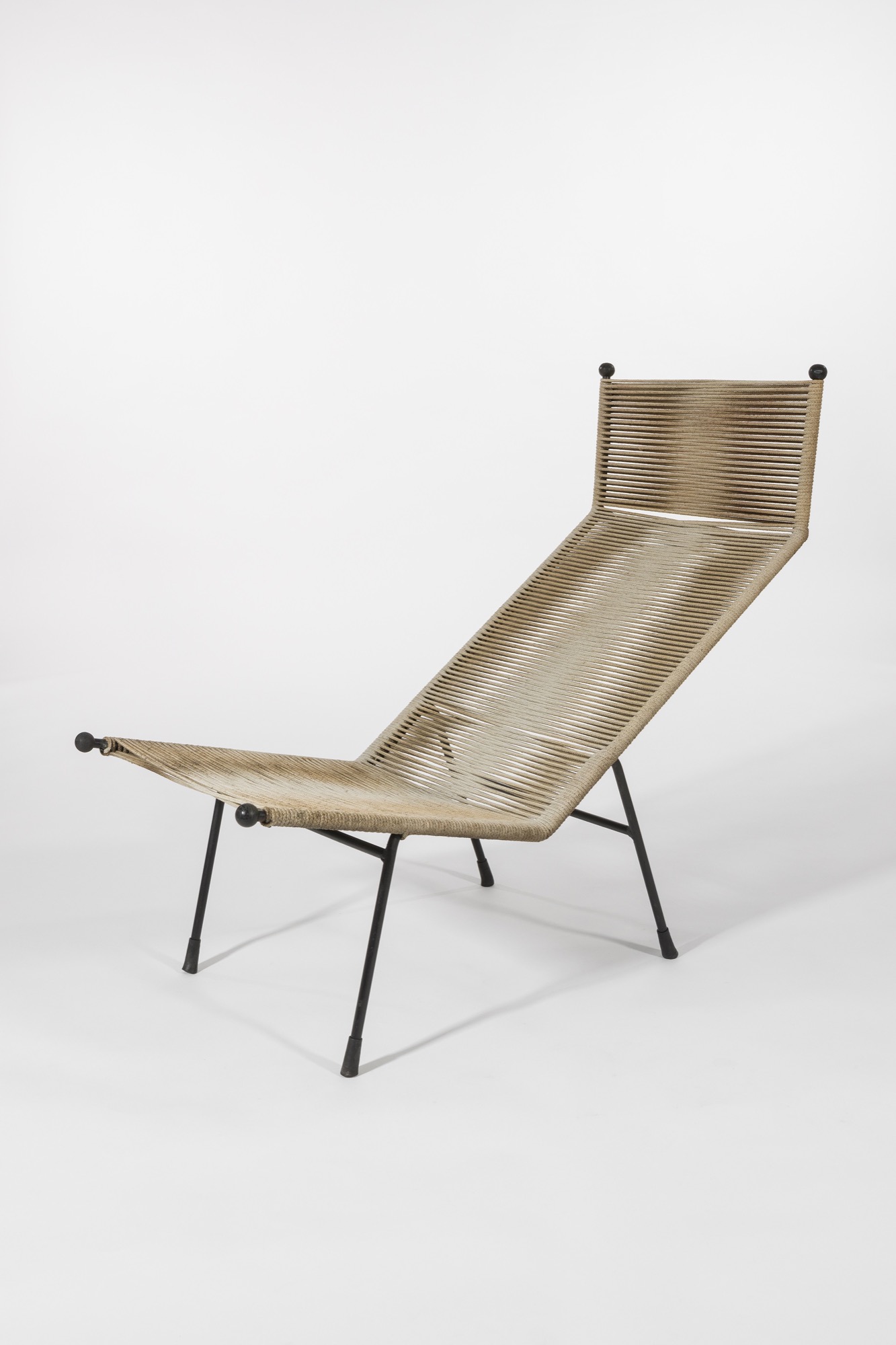
Clement Meadmore:The art of mid-century design admirably fills this gap. Ten years of research on the part of guest curators Dean Keep and Jeromie Maver, including a creative fellowship at the State Library Victoria, has enabled them to source a near-to-complete range of Meadmore’s designs. Most of the works are lent from private collections, reflecting the curators’ extensive networks among modernist furniture collectors, while their contact with Meadmore’s family has resulted in some fascinating loans, including a scrapbook of newspaper clippings, photographs and sketches that document Clement and Enid Meadmore’s life together, 1950-56. Enid Meadmore’s contribution is usually missing from any discussion of Meadmore’s design work, but here her involvement with the ‘cottage industry’ of weaving those iconic 1951 cord chairs is fully credited, while a hand-written testimonial she wrote in later life gives a detailed, personal and deeply wounded account of the cord chair’s origins. Archival discoveries such as these illuminate and provide depth to the exhibition, so that it is a far cry from simply a desirable display of chic chairs.
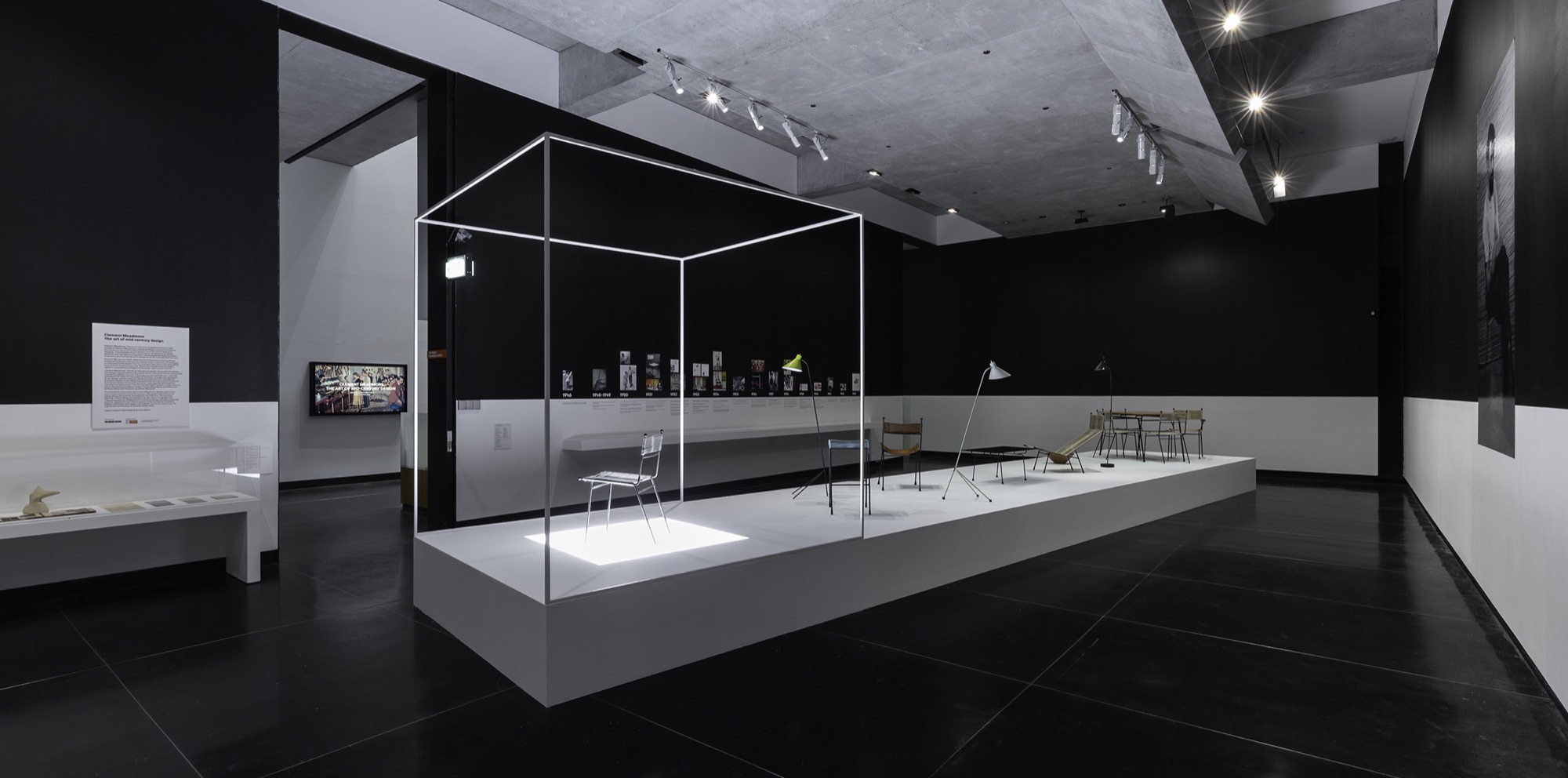
Similarly the exhibition design, by Alan Pert and Dhanika Kumaheri of Parallel Practice, is thoughtful and highly effective. On the Potter’s ground floor there is a series of cubic steel frames, powder-coated white, which delineate hypothetical rooms and settings for Meadmore’s furniture and lighting. These devices recall the sorts of room exhibits we might associate with early architectural trade shows, yet they avoid any suggestion of a period hang by their sheer simplicity of form. Indeed, the contemporaneous look of the exhibition design underscores the enduringly contemporary look of Meadmore’s furniture. Moreover, the simple frames, extending in space in three-dimensions, subtly echo the open work steel construction of the furniture itself. They remind us that this is a linear design ethos, open to surrounding space, outlining it rather than embodying bulk or occupying volume. It is a design ethos characteristic of Meadmore’s Italophile leanings, in contrast to the more Anglophile origins of Grant Featherston’s chairs, recently shown at Heide, which prioritised soft padded comfort over linear flair.
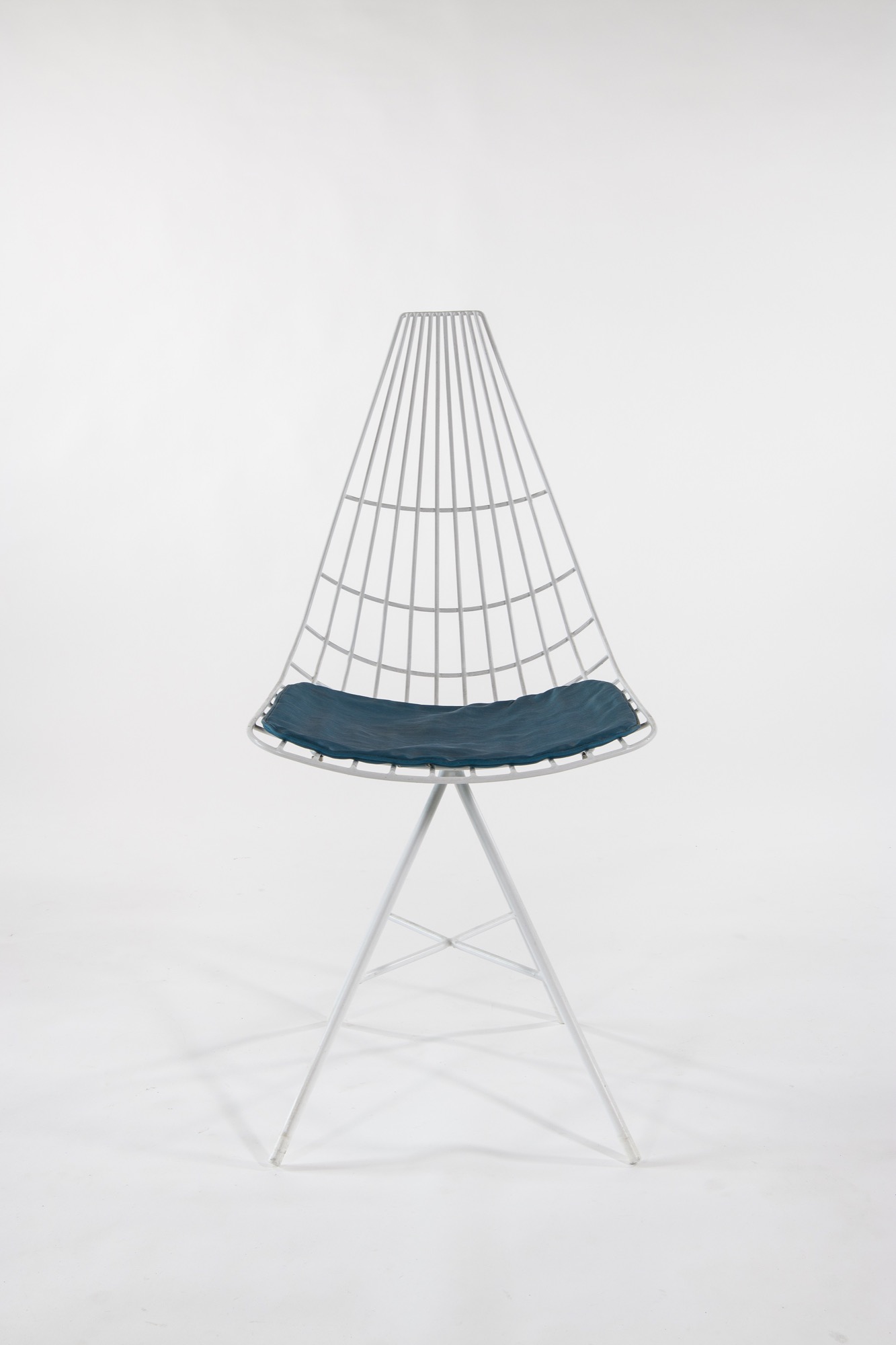
The white cubic frames also contrast effectively with the Potter’s surrounding ground floor walls, which have been painted two-tone for the exhibition: black for the upper two thirds of the walls and white at the bottom. The stark dividing line acts as a proxy dado-rail on which to arrange a sequence of images reproduced from Architecture and Arts magazines of the 1950s, illustrating Meadmore designs, as well as personal photographs from the family’s collection. A timeline accompanies these images down one wall of the gallery. The simple contrast of black and white helps structure and bring order to what otherwise could be an overwhelming amount of visual and textual data. It also metaphorically asserts the rigour of the curatorial selection. There are no grey areas—no ‘ifs, buts or maybes’—in this exhibition. Despite the proliferation of Meadmore copyists who arose in the wake of his legal battles with manufacturers, and the subsequent confusion over attribution of Meadmore designs, archival research and provenance has enabled the curators to definitively authenticate each work in the exhibition. The black and white colour scheme subconsciously reinforces their authorative attributions.
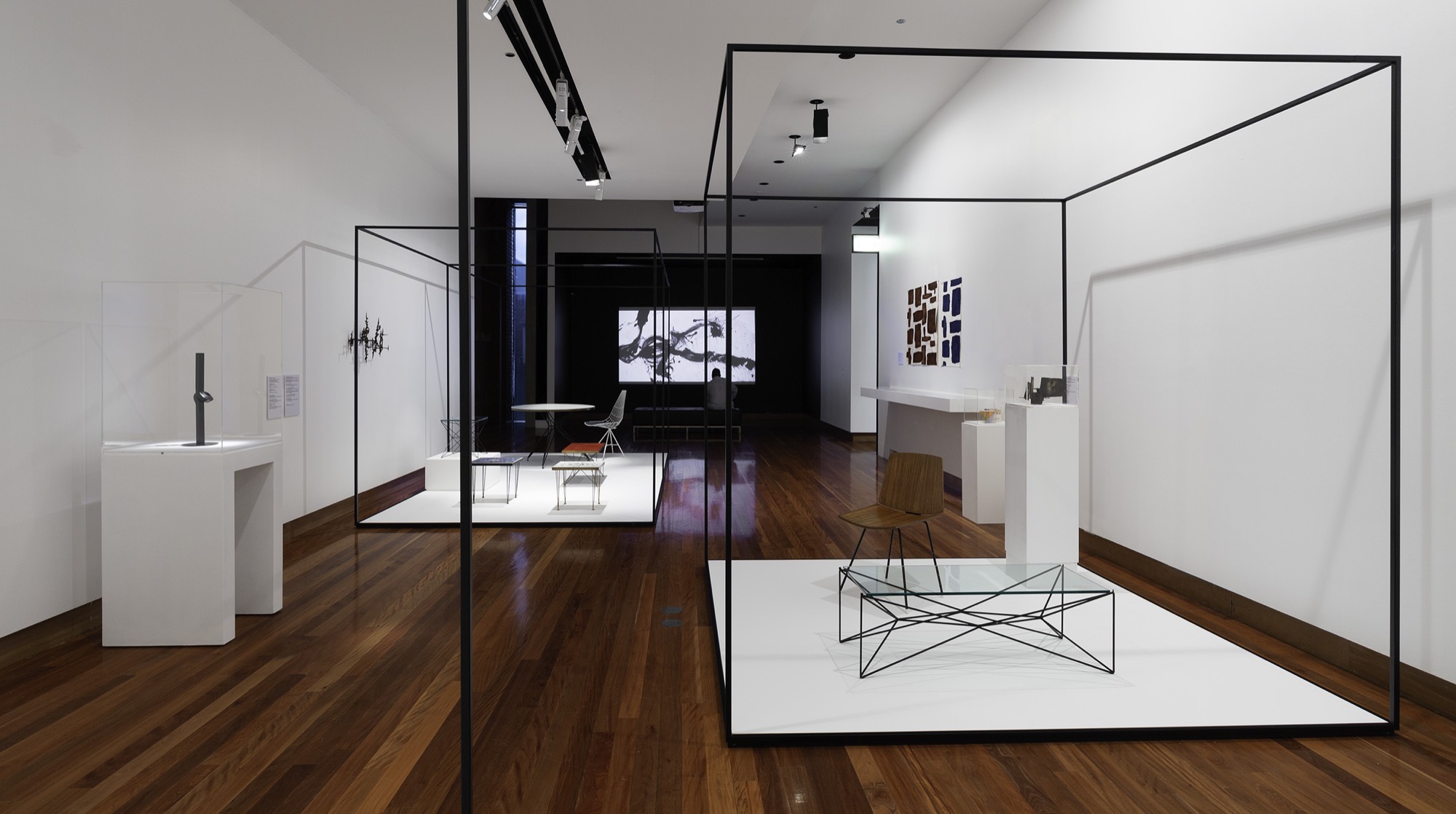
One floor up and the white cubic frames switch to black, here contrasting with the more usual all-white walls. The black steel frames reiterate the black steel legs of the Meadmore tables and chairs displayed on this floor, while the white walls are a simple foil to the hanging textile designs for Sekers Fabrics Kaldor and a late 1950s sculptural relief. The only exception to the black frames is a tanned-leather sling chair on a stainless steel frame: Chair (model 248), 1963. This sumptuous item was Meadmore’s last chair, made in New York, in 1963, when he apparently still ceded to friends’ requests for interior design help in their apartments.

Another surprise lays in wait in this room: the Rainbow Box, a Bauhaus-inspired toy demonstrating the mixing of colours through a clear acrylic cube filled with overlapping sheets of coloured Perspex, which Meadmore designed in 1970 for a British toy manufacturer. Complete with original packaging, this small exhibit highlights the vital part art can play in product design—particularly in the field of educational toys.

The two other gallery spaces on the Potter’s first floor are dedicated to Meadmore’s life-long involvement with jazz music and his contribution to Melbourne’s 1950s café culture. In the smaller space, all-black walls create an intimate space evocative of a smoky jazz club. One wall presents a mural collage of Meadmore-designed album covers, while on the other side we find archival photographs and documentary footage of Meadmore playing with such local jazz luminaries as Graeme Bell. The larger space, the Grimwade Gallery, painted an acidic fifties blue, contains original chairs and lights Meadmore designed for the Legend Espresso Bar and the Teahouse. Leonard French’s seven panelled mural, The Legend of Sinbad the Sailor, 1956 (Latrobe University Art Collection), fills one wall, while items of ephemera such as the Legend’s menu folder designed by French and Meadmore’s architectural plans for the café fitouts fill a display case against the opposite wall. Meadmore’s welded steel relief logo for the Legend is blazoned on the wall at the top of the first floor stairs, reminding us we are at a threshold where Meadmore’s design work and sculptural work are closely interconnected.

The inclusion of a small number of Meadmore sculptures throughout the exhibition, from a small 1948 clay torso to some of those magnificently weighty and ponderous monolith-inspired works of the early sixties, as well as a small editioned maquette of his better-known later bronzes, is an interesting choice. It supports the idea that Meadmore’s design practice was intricately tied up with his sculptural practice and raises a number of valid questions, such as: to what extent did Meadmore’s furniture designs reflect his sculptural interests in volume and space, and, conversely, how did an early career in industrial design impact on Meadmore’s development as a sculptor? While it is not the curators’ aim here to connect these dots, the questions are posed and the answers hypothetically phrased by the works on display. Suffice to say here is that such a thoroughly researched and expansive exhibition of the work that preoccupied Meadmore for over a decade can only deepen our understanding of his sculpture—both the work he made during the fifties and early sixties and the work he made subsequent to leaving Australia and his design origins behind.
Jane Eckett is a sessional coordinator in the art history and gender studies programs at Melbourne University.
Title image: Clement Meadmore: The art of mid-century design, installation view, Ian Potter Museum of Art, the University of Melbourne, 2018. Photograph: Christian Capurro.)


